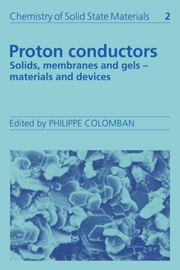Book contents
- Frontmatter
- Contents
- List of contributors
- Preface
- Symbols
- I HYDROGEN BOND AND PROTONIC SPECIES
- II MATERIALS: PREPARATION, STRUCTURES AND PROPERTIES
- 7 Structure and characterization of hydrogen insertion compounds of metal oxides
- 8 High temperature proton conductors based on perovskite-type oxides
- 9 Highly ionic hydroxides: unexpected proton conductivity in Mg(OH)2 and homologues
- 10 Ice
- 11 Anhydrous materials: oxonium perchlorate, acid phosphates, arsenates, sulphates and selenates
- 12 Hydrogen behaviour in graphite–nitric acid intercalation compounds
- 13 Proton-containing β- and β″-alumina structure type compounds
- 14 Proton conduction in zeolites
- 15 Proton containing NASICON phases
- 16 Phosphates and phosphonates of tetravalent metals as protonic conductors
- 17 Hydrogen uranyl phosphate, H3OUO4PO4. 3H2O (HUP), and related materials
- 18 From crystalline to amorphous (particle) hydrates: inorganic polymers, glasses, clays, gels and porous media
- 19 Perfluorinated membranes
- 20 Mixed inorganic-organic systems: the acid/polymer blends
- III PROTON DYNAMICS AND CHARGE TRANSPORT
- IV PROTON DIFFUSION MECHANISMS
- V DEVICES
- Index
8 - High temperature proton conductors based on perovskite-type oxides
Published online by Cambridge University Press: 04 May 2010
- Frontmatter
- Contents
- List of contributors
- Preface
- Symbols
- I HYDROGEN BOND AND PROTONIC SPECIES
- II MATERIALS: PREPARATION, STRUCTURES AND PROPERTIES
- 7 Structure and characterization of hydrogen insertion compounds of metal oxides
- 8 High temperature proton conductors based on perovskite-type oxides
- 9 Highly ionic hydroxides: unexpected proton conductivity in Mg(OH)2 and homologues
- 10 Ice
- 11 Anhydrous materials: oxonium perchlorate, acid phosphates, arsenates, sulphates and selenates
- 12 Hydrogen behaviour in graphite–nitric acid intercalation compounds
- 13 Proton-containing β- and β″-alumina structure type compounds
- 14 Proton conduction in zeolites
- 15 Proton containing NASICON phases
- 16 Phosphates and phosphonates of tetravalent metals as protonic conductors
- 17 Hydrogen uranyl phosphate, H3OUO4PO4. 3H2O (HUP), and related materials
- 18 From crystalline to amorphous (particle) hydrates: inorganic polymers, glasses, clays, gels and porous media
- 19 Perfluorinated membranes
- 20 Mixed inorganic-organic systems: the acid/polymer blends
- III PROTON DYNAMICS AND CHARGE TRANSPORT
- IV PROTON DIFFUSION MECHANISMS
- V DEVICES
- Index
Summary
Introduction
High temperature proton conducting solids are useful materials for many electrochemical applications such as high temperature fuel cells, hydrogen sensors and hydrogen gas separators. However, many protonic conductors decompose at temperatures above 300 °C. About ten years ago, the author found that certain perovskite-type oxide solid solutions exhibit protonic conduction in an atmosphere containing hydrogen or steam at high temperatures. In this chapter, proton conduction in perovskite-type oxides and their electrochemical properties are described.
Proton conducting solids at high temperature
Fig. 8.1 shows the conductivities of representative protonic conductors as a function of temperature. Although there are many good proton conducting solids at low temperature, they are unstable at temperatures above 300 °C since they decompose to liberate water. In earlier work, the existence of protons in Cu2O, CuO, NiO, ZrO24 and ThO25 in a hydrogen-containing atmosphere at high temperatures was studied, and the possibility of protonic conduction in those oxides suggested. However, their protonic conductivities below 1000 °C were expected to be quite low compared to those of low temperature proton conductors. Furthermore, these studies did not provide a direct demonstration of protonic conduction. After the discovery of SrCeO3-based protonic conductors, KTaO3–based oxides and Y2O3 ceramic were reported to have protonic conduction at high temperatures, although the conductivities were not as high as those of the cerate-based perovskite-type oxide ceramics.
- Type
- Chapter
- Information
- Proton ConductorsSolids, Membranes and Gels - Materials and Devices, pp. 122 - 137Publisher: Cambridge University PressPrint publication year: 1992
- 16
- Cited by



